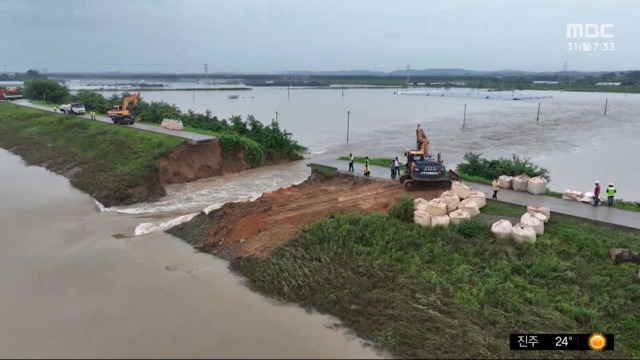This is a picture of water pouring in as the nonsan stream levee collapses in Chungcheongnam-do.
Around 5:40 in the morning.
A section of the embankment 11.5 m high and 50 m long collapsed.
It is estimated that 250,000 tonnes of water hit the town at a rate of 90 tonnes per second.
Temporary repairs have stopped the burst dam, but it is an uneasy situation because we do not know when heavy rain will pour again.
This is Jicheon, Cheongyang-gun, Chungcheongnam-do, which flows into the Geumgang River.
11:30 at night.
An embankment 6 stories high in an apartment building collapsed.
A torrent of water rushed through the collapsed area at 400 tons per second and engulfed the town.
It is estimated that about 1.5 million tons of water poured in as the 15m high and 50m long section of the embankment collapsed.
That’s over 400 Olympic swimming pools.
Except for the telephone pole, everything was out of sight.
[전수병/청양군 청소1리 이장]
″It’s locked. (Above my height?) What is your height? The house is all locked.”
More than 300 levees collapsed nationwide during the rainy season.
249 of them were concentrated in Chungcheong and Gyeongbuk.
The cause of the collapse of the embankment can be analyzed in two main ways.
First, it is an extreme heavy rain that exceeds the design frequency of the levees.
[권현한/세종대 건설환경공학과 교수]
″These streams are usually designed for an 80-year frequency. It is designed to be sized for flooding on average about once every 80 years.″
However, the rain that poured into Cheongyang and Nonsan reached a maximum of 544 mm over the two days.
Stochastically, it was analyzed as an extreme storm with a frequency of once every 200 to 1300 years.
[권현한/세종대 건설환경공학과 교수]
″It is estimated that the rain that fell in a specific spot is more than 1,000 years old.″
This year’s rainy season was recorded as one of the strongest in meteorological observation history.
What is the cause of this extreme rain?
This shows water vapor entering the sky over the Korean peninsula.
Red ones can dump about 60mm per hour, while bright pink ones can pour up to 70mm or more per hour.
Huge water vapor turned into heavy rain when it met the monsoon front and low pressure.
An ‘atmospheric river’ phenomenon, in which water vapor from the subtropical waters of the western Pacific flows in like a huge river, has also appeared.
When the rivers of heaven ran out of control, the rivers of the earth overflowed.
In summer, a lot of water vapor comes in, but this year, more water vapor than usual came in at once.
Climate change is one of the causes of the massive inflow of water vapor into the Korean Peninsula.
Due to global warming, the Earth’s temperature has risen by 1.1 degrees.
Water vapor increases by 7% for every 1 degree increase in temperature.
How much is 7% water vapor?
In terms of weight, that’s over 890 billion tonnes.
The world’s largest dam, Sansha Dam, is about 39.3 billion tons.
The same water as the bursting of 22 Sansha Dams was released into the atmosphere.
Korea is one of the places where the released water vapor turns into heavy rain and falls intensively.
Climate change has led to an increase in summer rainfall on the Korean Peninsula, with the largest increase in July.
Before 1995, the national average was 367 mm, but after 1995, it increased by 21% to 444 mm.
[손석우/서울대 지구환경과학부 교수]
″The increase in extreme precipitation is more pronounced than the increase in overall precipitation. So when it rains, it rains more.”
The rain that comes in August and September after the rainy season is also changing terribly.
The heavy rain in the metropolitan area that caused the Seoul semi-underground disaster last year occurred on August 8, and the Pohang underground parking lot disaster occurred on September 6.
Not only in Korea, but also all over the world, it is raining hard to imagine before.
A different response is needed now.
All of the embankments identified by the investigative team collapsed before the river overflowed.
The Cheongyang-gun embankment collapsed when the water level was 1m lower than the embankment, and Nonsancheon Stream was 4m lower than the embankment.
[권현한/세종대 건설환경공학과 교수]
″(Where it collapsed) seems to have been a relatively weak point of vulnerability. The dike (appears to have burst) as the water seeps into it.″
First of all, we learned a lesson about the importance of maintaining the existing levees.
However, it is also clear that existing levees with a design frequency of 50 to 200 years cannot completely prevent extreme storms.
Budget is limited, but we can’t repair all the levees across the country at once.
We need to change from the important point.
Urban areas, densely populated areas, and industrial complexes where human casualties are expected require strong defense measures that exceed current design standards.
Early warning is just as important as reinforcing levees to reduce human casualties.
When the levees break, water rushes into the village.
There is little time to evacuate when a dam bursts, especially at dawn or late at night.
[최명복/청양군]
″(The water came in in an instant?) It came in in an instant. If you’re not careful, everyone here is dead.”
A flood warning is issued before the levee collapses.
When a flood warning is issued, the evacuation system must be strengthened so that people can evacuate immediately even at dawn or in the middle of the night.
It was a climate environment report.
2023-07-30 22:42:57
#기후환경 #리포트 #rivers #sky #overflow #earths #banks #collapse #earths #vapor #bursts #Sansha #Dams


